If you’re running Facebook ads, you’re likely familiar with the terms of prospecting and retargeting campaigns. One of the most common audience segmentations in Facebook ads is prospecting vs. retargeting.
Segmenting your audience into prospect and retarget groups can yield significant benefits, including better budget management and reduced customer acquisition costs.
In this blog post, we’ll explore the differences between prospecting and retargeting campaigns. By the end, you’ll have a clear understanding of how to effectively implement these strategies in your Facebook advertising efforts.
Prospecting vs. Retargeting Facebook Ads
In Facebook advertising, especially for e-commerce businesses, the two primary campaign types are often categorized as prospecting and retargeting. But, what is the difference between the two?
Let’s start by explaining prospecting campaigns.
With prospecting campaigns, you reach new customers who haven’t interacted with your brand before. The goal of prospecting campaigns is to generate awareness and attract new users to your store. Also, prospecting campaigns typically use broad targeting.
As you can imagine the retargeting ads are completely different than prospecting ads. The retargeting ads target customers who have already interacted with your brand in some way. This could include visiting your website, adding items to their cart, engaging with your social media profiles, or even past customers.
Retargeting ads aim to encourage these users to take the next step, such as making a purchase, by reminding them of what they viewed or offering them incentives like discounts.
In essence, prospecting ads focus on reaching new potential customers, while retargeting ads focus on re-engaging with users who have already shown some level of interest in your brand or products. Each serves a distinct purpose within a comprehensive Facebook advertising strategy.
Prospecting vs. Retargeting Budget Split
The recommended budget split between prospecting and retargeting ads can vary depending on factors such as your industry, target audience, advertising goals, and overall marketing strategy.
However, a common approach is to allocate a larger portion of your budget to prospecting ads initially to attract new customers and then allocate a smaller portion to retargeting ads to re-engage those who have already shown interest.
A general guideline might be to allocate around 70-80% of your budget to prospecting ads and 20-30% to retargeting ads.
This budget split allows you to focus on acquiring new customers while also nurturing and converting existing leads.
Ultimately, the ideal budget split will depend on your specific business objectives and the effectiveness of each type of ad in achieving those objectives.
Suggested budget splits
As mentioned, the ideal budget split depends on your specific business objectives.
So, we could say that there’s no one-size-fits-all rule. However, here are some starting points for budget allocation regarding prospecting vs. retargeting Facebook ads.
- Start-Up or New Market Entry (Under 200,000 web visitors/month): 70-80% prospecting and 20-30% retargeting. This split helps build awareness and a customer base.
- Established Business with Steady Traffic (between 200,000 and 2M visitors/month): 50-60% prospecting and 40-50% retargeting. This helps maintain a balance between driving new traffic and maximizing conversions from existing leads.
- Mature Business Focusing on Optimization (over 2M visitors per month): 30-40% prospecting and 60-70% retargeting. For businesses with a solid customer base and brand recognition, focusing more on retargeting can help increase customer lifetime value and boost conversions.
These numbers are generalizations and can vary widely depending on the industry, market, and specific business model.
Budget split implementation tips
Continuous Monitoring and Adjustment is key to ensuring that your budget split between prospecting and retargeting ads remains effective.
Rather than sticking to a static allocation, it’s important to continuously monitor the performance of both types of campaigns. By regularly analyzing metrics such as conversion rates, click-through rates, and return on ad spend, you can identify which type of campaign is delivering the best results.
Also, don’t forget about seasonal adjustments. Seasonal Adjustments are crucial for adapting your budget split to changing consumer behavior and market dynamics.
Consider how seasonal trends or specific sales events might impact the effectiveness of prospecting versus retargeting ads. During peak shopping seasons or holidays, for example, retargeting ads may be more effective at converting leads who have already shown interest. In contrast, during slower seasons, you might allocate more budget to prospecting ads to attract new customers.
Copy Optimization Prospecting vs. Retargeting
When creating Facebook ads for both your prospecting and retargeting audiences, it’s important to tailor your approach rather than using the same ads for both.
Why? Because these audiences are at different stages of the buying process, they respond differently to different types of communication.
To figure out what works best for each audience, we analyzed over 4000 ads to see which ad copy elements affect the return on ad spend positively or negatively.
What did we find? For prospecting campaigns, mentioning things like free shipping, promotions, or product prices tends to have a positive impact on ROAS. On the other hand, using social proof or urgency in ad copy doesn’t work as well and can hurt ROAS.
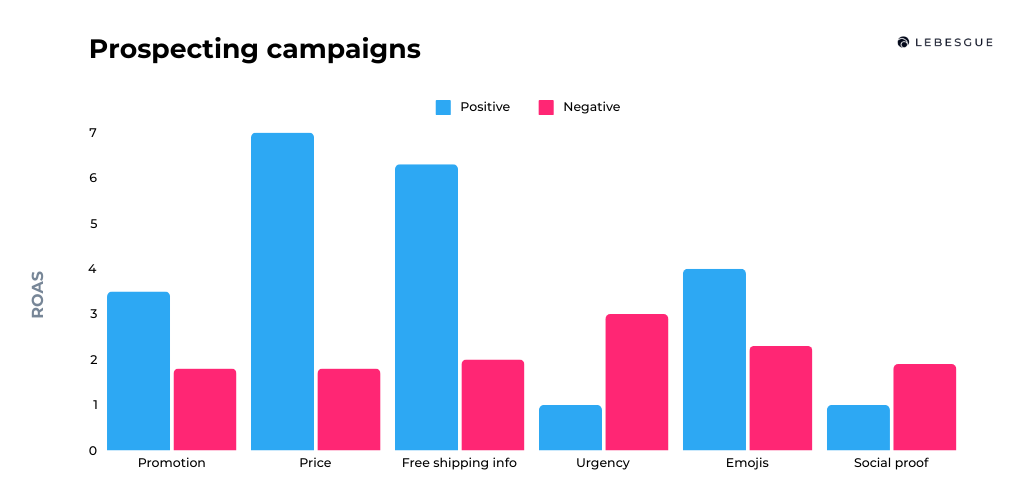
For retargeting campaigns, it’s the opposite. Urgency and social proof tend to work better because the audience already knows about your product or service. They want to see testimonials and feel reassured before making a purchase.
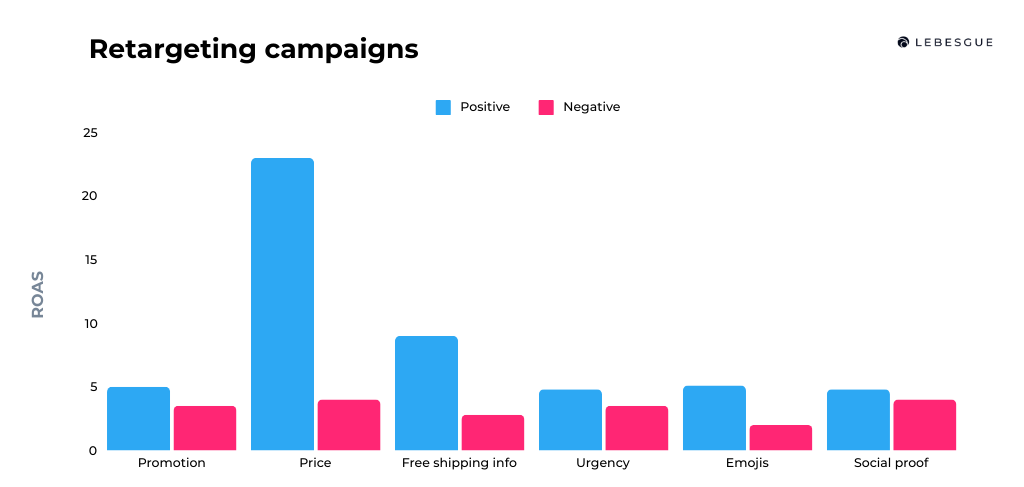
So, it all comes down to understanding your audience and speaking to their specific needs and preferences.
Types of Retargeting Audiences on Facebook Ads
When creating retargeting audiences you have more options than creating prospecting audiences. The key types of retargeting audiences you can use for Meta ads are the following:
- FB/IG Engagers: This audience includes users who have interacted with your content on Facebook or Instagram. Interactions can include likes, comments, shares, video views, or clicks on your profile. Targeting these users can be effective because they have already shown some interest in your brand.
- Website Traffic: You can target people who have visited your website or specific pages on your site. Using Facebook Pixel, you can create custom audiences based on their activity, such as visiting certain product pages, spending a specific amount of time on your site, or reaching a key page like the checkout.
- Email Sign-Ups: Those who have signed up for your emails or newsletters show a higher level of interest in your offerings. You can target these users with special offers or new products that might interest them, encouraging them to make a purchase.
- Previous Customers: Targeting users who have previously made a purchase can encourage repeat business. You can promote related products, and upgrades, or even offer loyalty discounts to increase their lifetime value.
What to Beware Of with Retargeting Audiences
When you’re using retargeting in your marketing, it’s essential to avoid some common problems. Retargeting can boost sales and remind people about your brand, but there are things you need to watch out for to do it right.
First, you’ve got to find the right balance. You don’t want to show your ads too much because that can annoy people. But you also don’t want to show them too little, or they might forget about you. It’s all about getting the timing right.
Next, you need to follow the rules about privacy. Some laws say you have to be clear about how you’re using people’s information and get their permission. It’s important to respect people’s privacy and keep their data safe.
When you’re targeting your ads, make sure you’re showing the right ones to the right people. For example, if someone has already bought something from you, it doesn’t make sense to keep showing them ads for the same thing. You want to show them something new or different.
Finally, make sure your retargeting ads fit in with your other marketing efforts. You want everything to work together smoothly to remind people about your brand and encourage them to buy from you.
Prospecting vs. Retargeting Advertising Metrics
When we compare the metrics for prospecting and retargeting Facebook ads, we notice several key differences.
Firstly, prospecting ads boast a slightly higher CTR at 1.28% compared to retargeting ads, which stand at 1.14%.
This indicates that prospecting ads excel at capturing initial interest from customers who are not yet familiar with the brand or products.
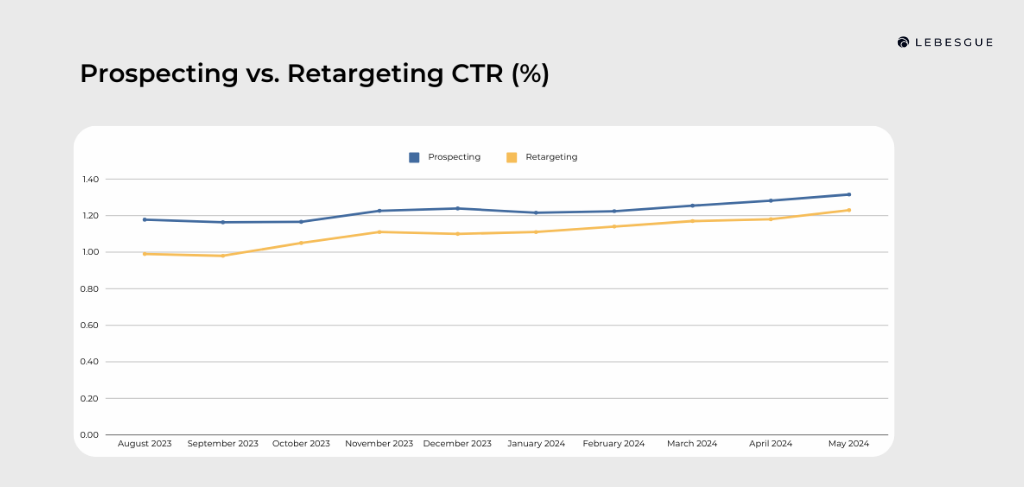
However, the real standout is in the CR. Retargeting ads significantly outperform prospecting ads in this aspect, boasting a conversion rate of 2.86% compared to prospecting ads at 0.99%.
This significant difference highlights the effectiveness of retargeting ads in converting users who have already expressed interest in the brand or products.
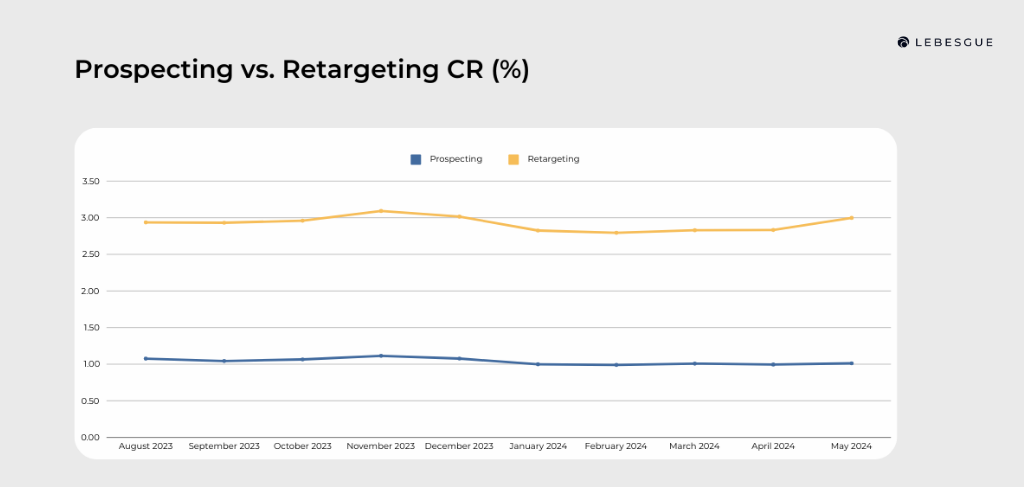
In terms of cost, retargeting ads have a slightly higher CPM compared to prospecting ads. Retargeting ads come in at $8.43 CPM while prospecting ads are at $7.50 CPM.
Despite the higher CPM, the increased conversion rate of retargeting ads often results in a higher ROAS compared to prospecting ads.
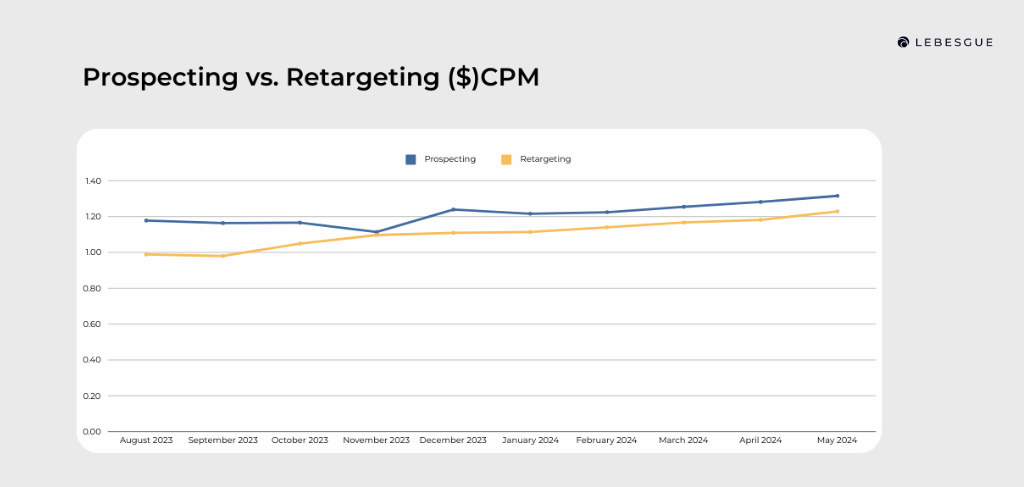
Even though retargeting ads may seem successful with lots of clicks and sales, we need to dig deeper. The real test is whether they bring in new customers who only bought because of the ads.
If sales aren’t growing with new customers or even dropping, it might mean we’re too focused on these ads and not finding new ways to grow.
Summing Up
And that’s it. Now that you understand the difference between prospecting vs. retargeting Facebook ads, you can structure your campaigns more effectively. By targeting new audiences with prospecting and engaging interested users with retargeting, you’ll optimize your advertising strategy for better results.



